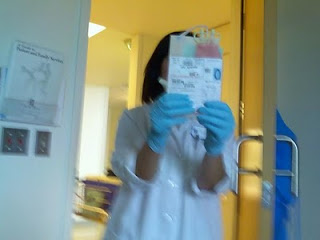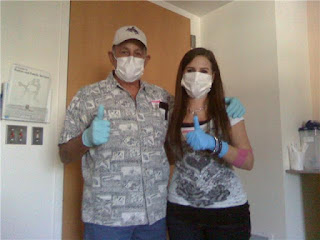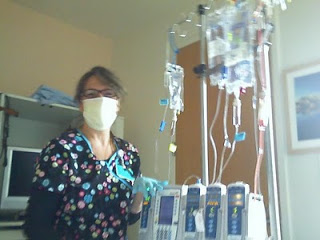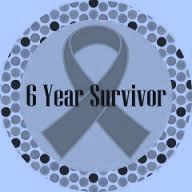July 5, 2010 = Stem Cell Transplant Infusion success
July 5, 2016 = Still here Myeloma! Who's Winning?
July 5, 2016 - Began higher dose Kyprolis
July 6, 2016 - 2nd infusion of higher dose Kyprolis.
7.6.16
6 years ago today I was surprised to be feeling rather ok after my completely non-dramatic, anti-climatic Stem Cell Transplant Infusion. Seems like more of a Big Deal is made of the Stem Cell Infusion itself, then the intense cancer killing chemo infusions preceding the stem cell transplant-infusion. I know now (and sure learned then), that it's really the 2 days of high dose
Melphalan chemo that becomes the monster.
Melphalan completely depletes the patient's immune system, systemically killing off the good and the bad cells. So many suffer so terribly from the intense chemo, which is dosed to render myeloma dead and dysfunctional. Our stem cells are infused back to regenerate our system, re-boot us to remission, hopefully
eliminating, suppressing the cancerous myeloma cells for a long time. (This is a very simplistic explanation, for the real, medical scientific details, just Google in
Autologous Stem Cell Transplant, and you'll get all the detailed details of the procedure!)
7.5.2010
Stem Cell Delivery!
Jim and Alissa there to share in the Big Moment!
I remember feeling relatively ok for a few days after the high dose chemo and
SCT infusion, wondering what the Big Deal was about this procedure. Nurses and Doctors continually "warned" us patients that the "crash"
(Nadir) is coming.. be warned, be ready. Follow all the recommendations for sanitized health. Wash, cleanse inside and out, swish the oral antibiotics, hydrate, move around, don't get bed ridden, do whatever you can to stay strong. Watch out for the evil mouth sores
(mucositis). Eat well, but cautiously. I remember having stereo vomiting in surround sound, from the adjoining rooms on both sides of me. We all had private rooms, but the walls weren't perfectly insulated. I remember keeping the TV on 24/7 to drown out the suffering of my invisible neighbors. I felt so bad for their suffering. I vowed to not wind up like that. I barely ate, paying attention to my body's signals. I ate simply and minimally. I remember the cafe staff calling if we didn't order each meal. I learned to order something, just to order, just have it, just be left alone, but always appreciating their caring protocol. Plain baked potatoes. Clear juices thinned with water. Cream of Wheat. Plain oatmeal. Canned fruit. Nothing fresh allowed. Too much bacterial risk. Our diets were called the "anti microbial diet", or the "immunocompromised antibacterial diet", or the
"Neutropenic Diet" (Google those too!). The whole point is to avoid infection at all costs, as when Melphalan thoroughly kicks your systems butt, you have ZERO immune system protection. No internal Army, Navy, Marines, Seals or Swat team to protect you. I remember feeling ok at first... then each day a little worse, then continually worse... feeling blah, achy, fatigued, sickly, depleted...

The last time I left my room for 3 weeks
to walk my family to the elevator
Your body plummets to outrageously low blood counts. You begin to feel so awful, so sick, so yucky. It's indescribable if you've never been that sick, that weak, that incredible weakness and fatigue like non other. My goal daily was to get out of bed, grab my IV stand and (barely) make it to the bathroom, or just make it out of bed to the chair by the window. This was the beginning of my lovely lower GI issues. And I went down hill from there. And down hill I went and went. My Hickman Catheter became septicly infected. My chest insertion site was terribly infected. I had a constant crazy fever. I was really really sick. My medical team realized this. They wasted no time calling a surgeon to my room, and I had emergency bedside surgery to remove my horribly infected Hickman Catheter. I was told this was the worst Hickman Catheter infection they had ever seen. I was really really sick. I felt awful. I had no immune system to fight. My IV stand grew to bags and bags of IV antibiotics. 5 or 6 different antibiotics to keep me alive. Liquid IV nutrition and hydration at this time too. My surgery wound was awful, disgusting, seeping, oozzing infected poison. It felt gross and looked gross. This was between the 2nd and 3rd weeks. Medications now administered via hand and arm IVs. The medications blew up my poor veins. I had to have new IVs inserted daily. (That was was a big deal to me then, now, eh, whatever! used to it!) I refused a Port or Picc line as I was terrified to get another mainline infection. Oh how I suffered. I didn't want anyone to come see me. I told my family not to bother coming to see me. They came anyway. I tried to visit and talk, but eventually told them if they come, just sit, tell me stories, watch TV with me, nap with me. I watched more TV during July 2010 then I had ever watched in my entire life. My TV eventually burned out. The tech team came immediately to fix it. They knew this was our lifeline. They knew we needed the distraction and company. They knew we needed the nonsense noise to save our sanity.
Slowly my numbers rebounded. Slowly I began to feel a bit better. I began to chat more with the staff. I was so exhausted, so depleted. Funny though, word got around the floor I was a professional counselor, and staff members would come in to chat about their families, issues, college majors and registration. I don't think they realized how awful I felt, as I still had hair, and tried to always put a little make-up on. I always tried to hard to be me. The me before cancer. The me before the "new normal me". I called that time period the "Parade of Professionals", as so many types of caregivers came to see patients. Medical Social Workers. Occupational Therapists. Recreational Therapists. Doctors, Nurses rotating, assessing, recommending, so caring, so concerned. Wonderful, dedicated staff. Shift changes. New faces, tell my story over and over again. So challenged mentally and physically. I was so exhausted. So beat up. Blood tests constantly. Measure what goes in, what comes out. I focused on "Less is More". Less of everything. Keep the eye on the goal Julie. Get well, get home. Build your immune system back up. Get strong, beat this. Eating, drinking was a huge effort. Horrible horrible acid reflux like I'd never ever experienced. Never ever. Eye on the goal. Live in the moment, don't think of the future... too painful right then... How I tried to be so strong, but I was so depleted. I felt I would never get well or never get home.
They let me know the only way I would ever be released would be if I could swallow my meds, and get off the IV meds. Have you ever seen hospital issue Potassium pills. OMG, huge! So I asked for a liquid syringe. OMG that was even more awful. The taste gagged me. I said I would try to eat a banana a day. I said I would try to do a lot of things. I did try. Sometimes successfully, sometimes not. My whole day was trying to get nutrition in, have it stay in me, and make it successfully to my little bathroom just mini steps away. I remember I had Jim bring me juice Popsicles. I would be so parched in the middle of the night. I'd push the buzzer and ask for a Popsicle. That appealed to me and stayed with me. That little event, a huge task. The staff was so wonderful. Always offering help. Me, always too independent. I tried too hard to do too much on my own.
Wonderful amazing staff members!
Keep the TV on. Focus on the goal of getting well and getting home. Home seemed like a fantasy, as distant dream. A non reality. I became very emotional about everything. I didn't want to think about home, my family, my animals, my college life, my life beyond the hospital. Broke my heart, as I felt so broken. Felt like I would never ever recover. When the medical staff talked about my potential release, I begged them to not talk about it, if it wasn't going to happen soon. They told me again, the only way I could be released was to accept a Port or Picc line. Wonderful professionals came in to see me. To describe the procedure. They brought in the BEST technician, nurse, doctor who had been doing this for over 25 years and was going to retire any day. She said I could be her last Picc patient. I finally agreed. I was so scared. Scared of another septic infection. I accepted my situation. I agreed to the Picc line. The procedure was no big deal! Fear can be crippling. I was released a few days later! I don't think I have many pictures from this time period. They may be on my little old Razor phone. I think I deleted so much, as I didn't want the memories. It was a very very painful, challenging time in my life. Being isolated for a month in a hospital. You don't own your life. You are not in control of much of anything. You stare death in face 24/7. You wonder if you'll make it. You feel so awful, then suddenly, so ok. One of my Doctors later told me, he always remembered me, as I was the only patient that never unpacked. Yes, I left my clothes in my "carry on bag", on a chair, and I never unpacked. I never thought I'd be an isolated super sick inpatient for a whole month. I made it myeloma, and here I am recounting my 6 year stem cell transplant anniversary!

July 5, 2010 - July 5, 2016
***********
So we'll see how this new regimen of higher dose Kyprolis goes. Of course I was scared and hesitant to increase. Still am. But I did, yesterday and today. Always trying to preserve my organs. Organ failure is too common in myeloma treatments. I know of too many that tried too hard to reach remission. They did, but they over burdened their vital organs and didn't make it. My first day of this higher dose infusion stung a lot. I was dizzy and fuzzy afterwards. I should not have driven home, but I did. Always trying to be too independent. I always follow infusions with a lot of hydration via IV, plain water, and cranberry juice diluted with a lot of water. Cleanse those organs. Today, I asked my nurse to slow the infusion down. That was magic. No pain, just a little stinging. If you do IV infusions, don't rush it. Everyone is rushing about. Rushing to get to the next event. Rushing this, rushing that. Focus on the moment. Breathe. Make the moment matter. Make the moment comfortable. Speak up. I've learned. It's ok to not be strong all the time.

Today's chemo lab higher dose Kyprolis survival selfie.
I wonder what my "crash" will be,
My stupid, ridiculous horse poop trash can tripping and diving injuries are healing. I have lovely purple and yellow bruises on my face, arm and leg. But I am better. I hurt, I'm still swollen, but I am laughing more than I hurt. Live your life. Have fun. Be careful, be deep, be thoughtful, but be silly. Find joy in everything that is joyful to you. Yes, I'm right back out there scooping poop. I laugh at the contrast of being in the chemo lab for serious cancer chemo infusions one moment, then the next I am doing ranch chores. My horses (and all the other animals) have no idea my circumstances. They just want food, water and scratching. I love my life beyond cancer. I am very blessed and very grateful.

It's late, and I wasn't going to ramble and write this much. It just happened. Day 2 Dex to blame lol. It's really late, but so serene and peaceful. I have the windows open, there's a soft warm breeze coming inside. I've been hearing a hoot owl hooting for over an hour. Sounds so magical, mysterious. Makes me feel so alive, so grateful. I never ever forget that I've cheated death for 6.5 years!
Live happy,
live well, and make a difference somewhere, somehow, with someone or something
as often as you can!











Simply awesome post. Thanks for sharing with the universe.
ReplyDeleteHair Transplant in Delhi
Thank you for appreciating my blog from across the globe! How'd you find me? Do you know someone with myeloma? Thank you for checking in!
DeleteInspiring post. Now if you and anyone who wants the best hair transplant in india at low cost then you can easily contact with our clinic.
ReplyDeleteThank you for enjoying my blog and commenting from across the globe! Do you know someone with myeloma? Thank you!
DeleteGreat post Julie. I didn't get infections during my SCT but a lot of what you described, I had too. I'm not sure I could go thru it again, ever. I'm amazed at people,like Pat K that went thru 3 SCT. I certainly would not have that fortitude. Hey, I was a counselor too. My masters was in MFC counseling. I started a PHD program many years ago but never finished. so we have a lot in common.
ReplyDeleteChristina! OMG! I cannot believe our life similarities! Wow!! Yes, I agree with you on all that. I feel so devastated for Pat's loss. I just think he tried to hard to achieve remission and the elusive "cure". He just burned out his organs with such intense high dose treatments! Wonder what his Drs have to say on this retrospectively. Such a loss, such a tragedy :'(
DeleteI will email you. Crazy lives we have, but so glad to connect with you! xoxo
nice blog post. If anyone wants the best FUE hair transplant Doctors in India the you can visit our centre. We provide the treatment at low cost.
ReplyDelete